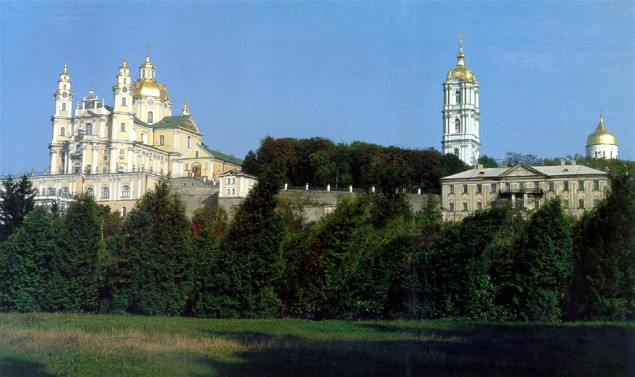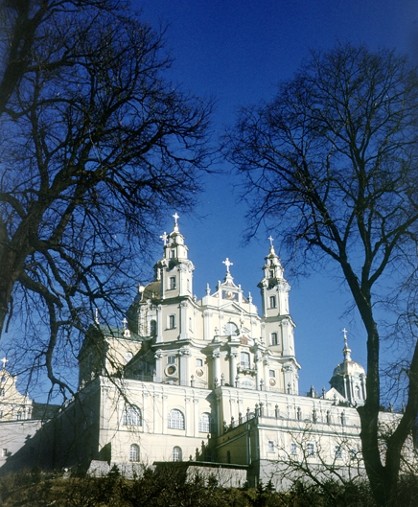Pochaiv Monastery
Pochaiv Monastery (Pochaivska lavra). (Photo: Pochaiv Monastery.) The largest monastery in Volhynia, and the second largest men's monastery in Ukraine, after the Kyivan Cave Monastery. Initially called the Pochaiv Dormition Monastery, it was founded, according to some accounts, by monks who fled from the Kyivan Cave Monastery at the time of the Tatar invasion of 1240. The first written mention of it dates to 1527. In 1597, the noblewoman A. Hoiska donated a large estate to the monastery, as well as a miracle-working icon that had been brought to Volhynia by a Greek metropolitan in 1559. The cloister flourished during the tenure of Hegumen Saint Yov Zalizo in the early 17th century. In 1649 F. and Ya. Domashevsky funded the construction of the monastery's Holy Trinity Church. In 1675 the monastery was attacked by Turks and Tatars but was reputedly saved by an apparition of the Mother of God; this event has been immortalized in many songs, including ‘Oi ziishla zoria vecherovaia’ (Oh the Evening Star Appeared). In 1713 the monastery officially joined the Uniate church and became a center of the Basilian monastic order, which developed it into an important cultural and publishing center and founded the Pochaiv Monastery Press in 1730. In 1771–83, the Holy Trinity Church was demolished and replaced by the Dormition Cathedral, funded by M. Potocki.
In 1831, the Russian government gave the monastery to the Russian Orthodox church on the pretext that its monks supported the Polish Insurrection of 1830–1. It also raised its status to that of a lavra. In 1833–41 the monastery was the see of the bishop of Volhynia, and after that its archimandrites were named Bishop of Ostroh. In the late 19th century an icon painting workshop and a historical museum were established, and many buildings were rebuilt or expanded. In the 18th to 19th centuries the monks of the monastery developed a distinctive style of liturgical singing. A number of hermitages were controlled by the monastery.
In the 20th century, under the Volhynian archbishop Antonii (Aleksei) Khrapovitsky, the Pochaiv Monastery became a strategic center of Russification, reactionism, and anti-Ukrainianism. The archimandrite V. Maksymenko was an influential supporter of the Black Hundreds movement and of publications such as Pochaevskii listok. During the interwar period, its archimandrite was the metropolitan of Warsaw of the Polish Autocephalous Orthodox church, but now he is the bishop of Lviv and Ternopil. After western Volhynia was incorporated into the Ukrainian Soviet Socialist Republic following the war, the Pochaiv area was annexed to Ternopil oblast, and the hierarch of Lviv-Ternopil served as archimandrite. The monastery lost its estates, falling victim to the antireligious policies of the Soviet regime. The number of monks declined sharply, from 200 in 1939 to 74 in 1959 and approx 12 in 1970. Nonetheless, efforts by the Soviet authorities to close the monastery outright in 1964 were met by protests of local Ukrainians and of the international community. The monastery remained open, but many of its artifacts were confiscated and housed in the Pochaiv Museum of Atheism, located at the monastery.
Before the Revolution of 1917, the Pochaiv Monastery was a popular destination for religious pilgrims, tens of thousands of whom came to celebrate the feasts of the Dormition (28 August) and of Saint Yov Zalizo (10 September). Among its most revered artifacts are a ‘footprint’ of the Mother of God, a miracle-working icon, and the relics of Saint Yov.
Architecturally, the Pochaiv Monastery appears as a complex of buildings uniquely adapted to the natural environment. The buildings are set on a cliffside, rising to a three-story terrace with a parapet. The terrace is the site of the central Dormition Cathedral, built in 1771–83 in the Rococo style by the Silesian architect G. Hoffman. The vast cathedral (it can accommodate 6,000 people) has eight large and seven smaller cupolas, and two large arches at the front. The sculptures within were created by Matvii Poleiovsky (1781–6), and the fresco on the dome was rendered by P. Preniatytsky. Luka Dolynsky painted the icons for the iconostasis, the ‘Miracle of Christ’ cycle, and 50 other smaller works, all in the Classicist style, and L. and I. Bernakevych crafted the engravings for the church. The cathedral suffered a fire in 1869, and only four of Dolynsky's works were saved, but the original appearance of the interior has been preserved in a drawing by Taras Shevchenko (1846). The cathedral was renovated in 1876 by local icon painters. Other buildings in the Pochaiv Monastery complex include the monks' cells (1771–80), which surround the cathedral, the bishop's residence (1825), built in the Classicist style, and a large bell tower (1861–71). The Trinity Church, constructed in 1910–13 after a design by Aleksei Shchusev, was built in the Novgorod style of the 12th to 13th centuries, and differs markedly from other structures in the complex.
BIBLIOGRAPHY
Khoinatskii, A. Pochaevskaia uspenskaia lavra: Istoricheskoe opisanie (Pochaiv 1897)
Antonovych, S. Korotkyi istorychnyi narys Pochaïvs’koï uspins’koï lavry (Kremianets, 1938; San Andres, Argentina 1961)
Ilarion (Ohiienko, I.). Fortetsia pravoslaviia na Volyni: Sviata Pochaïvs’ka lavra (Winnipeg 1961)
Dubylko, I. Pochaïvs’kyi manastyr v istoriï nashoho narodu (Winnipeg 1986)
[This article originally appeared in the Encyclopedia of Ukraine, vol. 4 (1993).]
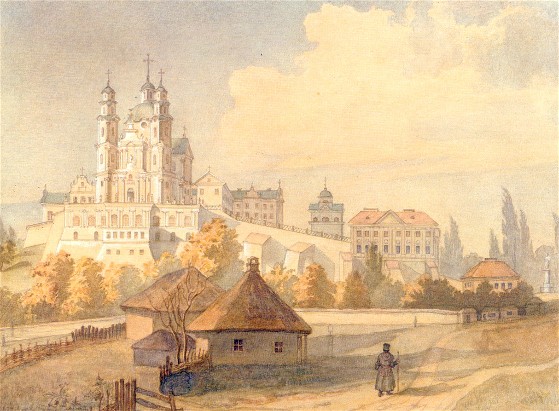
.jpg)
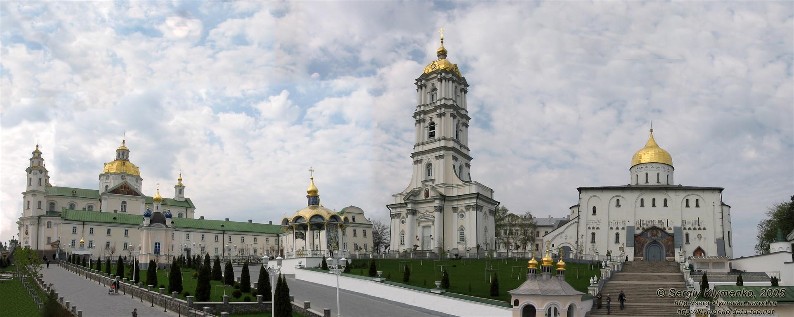
.jpg)
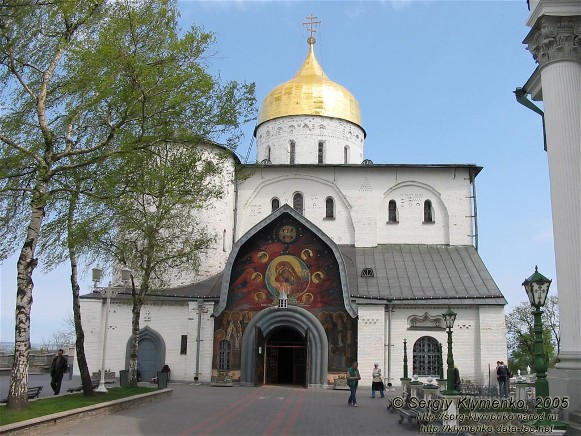
.jpg)
